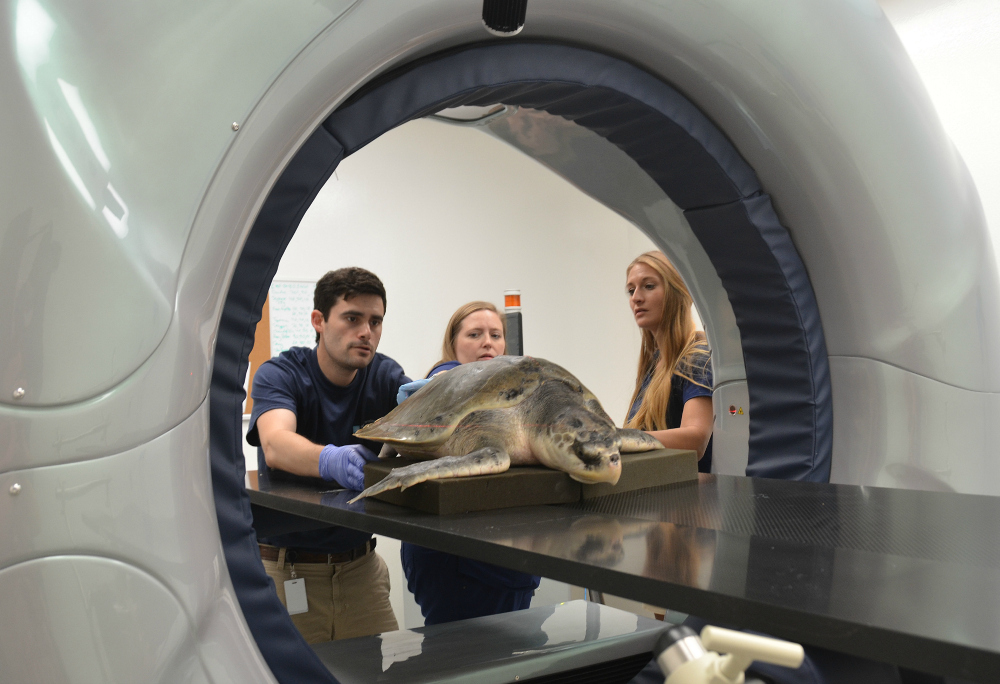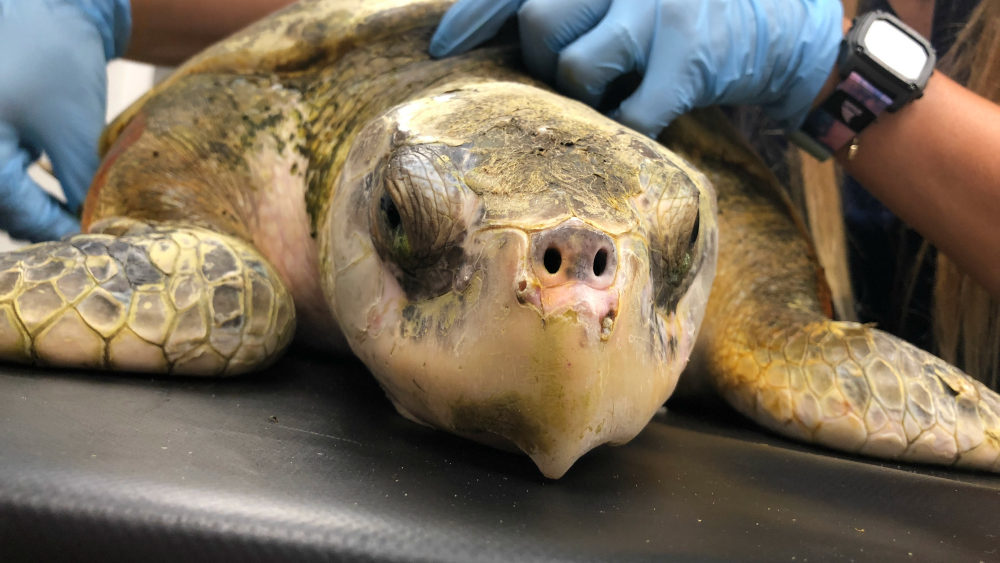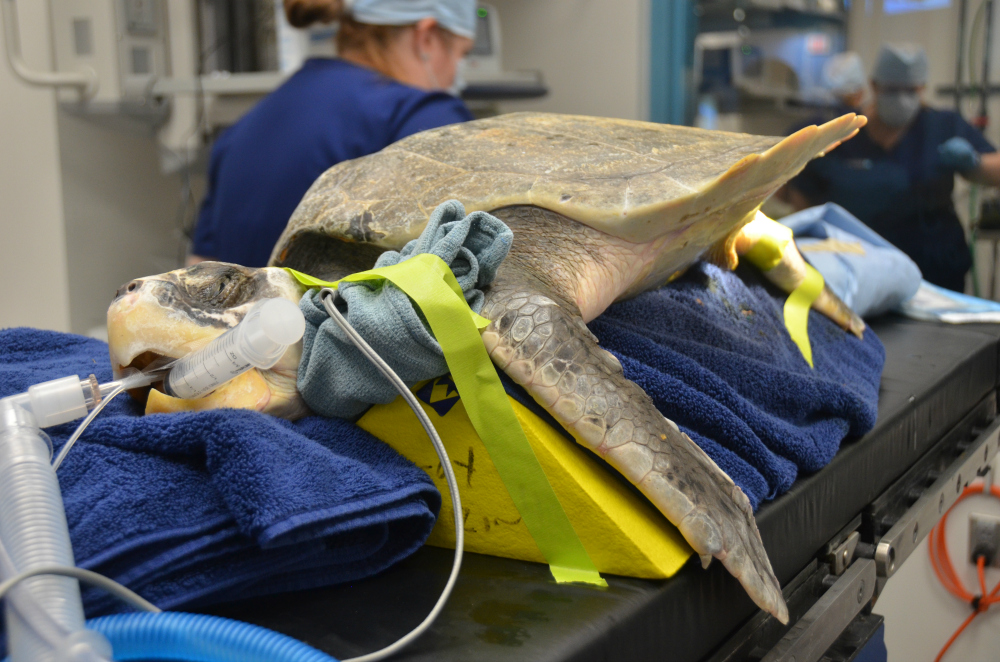Kemp’s ridley (Lepidochelys kempii)
Stranding Location: Kiawah Island, SC
Arrival Date: 05/22/2018
Age: Subadult
Weight: 13.82 kg (30.5 pounds)
Case History
This endangered sea turtle was found five miles offshore of Kiawah by Captain John Ward, who was out on the water for a fishing charter excursion. Ron Weasley was floating and unable to dive, a behavior that John knew was not normal for a healthy sea turtle. Despite Ron having no external physical injuries, John recognized this turtle was in distress and knew he needed to call South Carolina Department of Natural Resources (SCDNR). He brought the turtle aboard and quickly took it to Mingo Point on Kiawah Island. The turtle was met by SCDNR Sea Turtle Technician, Emma Schultz, who transported Ron to the South Carolina Aquarium Sea Turtle Care Center (STCC). This endangered sea turtle was very lucky to have been found, and was rescued not a moment too soon.
Treatment
Ron was met by STCC staff and interns eager to begin the triage process. When the doors of the SCDNR truck opened, it was immediately evident this turtle had either air or fluid in the subcutaneous space (under the skin) around his neck and flippers. This gave Ron an appearance of being bloated/inflated. Once in the medical facility, the triage team quickly began working up this case. A heart rate was taken, vitals assessed and blood pulled. When the admitting staff went to give the antibiotic injection, air was pulled up into the syringe. A sure-fire sign that air was indeed in the body cavity. Sea turtles, unlike humans, do not possess a diaphragm to separate the chest from the abdomen. Instead they have what is referred to as a coelom. Every time Ron took a breath the air would go through the lungs and escape into the coelom. As more and more air built up, the turtle started to inflate. The pressure of the air was compressing the lungs, and he was slowly suffocating. In order to remove that air, a needle and syringe was placed in the soft tissue space in front of the left rear flipper and the air manually removed. Almost instantaneously, Ron began to deflate and was able to inhale and exhale normally. As this was only a quick fix, Dr. Shane set to work on hooking Ron up to a wound VAC, which creates a constant suction of negative pressure. A small hole was drilled into the shell, which went directly into the coelom. The VAC was attached via a syringe and the negative pressure removed all excess air. Ron was placed in a foam water bed and hooked up to the wound VAC overnight. Security and staff monitored him throughout the night to look for any machine malfunctions or re-inflation of the body.
 Updates
Updates
May 23, 2018: Staff was relieved that Ron had made it through the night. The vet staff quickly began further diagnostics. Repeat CT scans were done to assess the damage to the lungs. Dr. Shane determined that he would need to go in surgically to find the presumed tear in the lung(s). Ron was prepped for surgery, a small incision was made in the left inguinal region and a rigid endoscope was used to see inside the body cavity to the lungs. Dr. Shane quickly found a tear to the top of the left lung and estimated it to be a few centimeters in length. Now came the question of-” how do we patch this?” In the past, we have successfully resolved a lung bulla by using a blood patch, like in the case of Glenn. Unfortunately, this tear was too large for that method. Instead, a series of poloxomer gel, surgicel, gel foam and rediheal was placed over the tear in hopes of creating a patch and to help promote healing. After the surgery, CT scans showed the lungs now inflating to 50%. A significant increase from just the day before. Ron woke up from anesthesia relatively quickly for a sea turtle (it usually takes several hours) and was placed on a foam water bed overnight to recover.
May 24, 2018: We kept Ron in shallow low-salinity water to heal comfortably after the surgery. Not too surprisingly, he is not yet interested in eating. Repeat CT scans and routine antibiotic injections are in his future. We will be closely monitoring Ron over the next couple days – prognosis is guarded.
June 1, 2018: This tenacious Weasley, has become significantly more active in the past couple days. Ron can be seen recovering from surgery in TR3 up in Recovery. Given that he underwent major surgery, we are keeping his water level low for the time being. You may notice him floating at the surface which might be an indicator that some air is still in the coelom. Later this week, Ron will be getting a repeat CT scan to monitor the lung patch and assess his lungs. In the past we have found that subadult Kemp’s ridleys tend to be on the pickier side when it comes to food. Ron appears to be no different. We have offered salmon, mackerel, smelt and blue crab. So far it seems like he has the most interest in crab. If he still isn’t eating in the next couple days, we will pull out the big gun – shelled shrimp! Hopefully that will appease his selective palate.
June 24, 2018: Over the past couple weeks, we have seen great improvements with Ron. He started to reliably eat and was able to rest completely on the bottom of his tank. However, last weekend he was unable to dive and would just float at the surface of the water. The water level was reduced and we prepared for the worst. Suspecting that his lung had re-ruptured, we did a repeat CT scan. The scan revealed that his body cavity had refilled with air, most likely caused by a lung tear/re-rupture. On Tuesday, surgery was conducted to re-patch the presumed opening of his original lung tear. Even after three hours of searching, a tear was never found. Though he recovered well from surgery, air had accumulated in his coelom overnight. On Wednesday morning, he was found unresponsive, but surprisingly still had a heartbeat. He was placed on a ventilator all day and some reflexes began to return. On Thursday, a third surgery was conducted to look again for the lung tear and patch it. Ron unfortunately never regained consciousness and the decision was made to humanely euthanize. A necropsy will occur on Monday, which will hopefully give us some additional answers to this interesting case and apply that knowledge to similar cases in the future.



